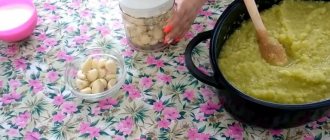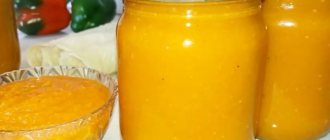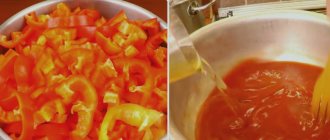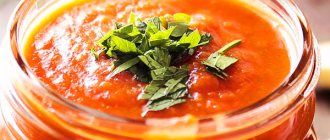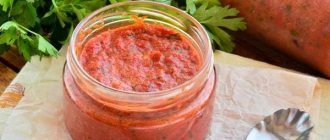Initially, adjika was prepared from hot pepper, salt and garlic. Modern cuisine also offers sweet versions of this dish. Sweet adjika goes well with meat dishes. It is prepared on the basis of bell peppers, tomatoes or carrots. The sauce becomes especially piquant when adding plums or apples.
Homemade adjika
Adjika, made with your own hands, allows you to greatly modify the recipe and choose a variation that is most suitable for the dish or personal taste preferences. Not many people like food that is too spicy, but tomato paste with a little pepper (adjika without bell pepper) can add some zest to the dish.
To ensure that the preparation is not too spicy, it is most often made using bell pepper - this is the most traditional recipe. Since several varieties of pepper combine optimally with each other to taste. However, this bright vegetable is not to everyone’s taste, so many housewives ask the question: how to make adjika without bell pepper? Let's look at recipes for delicious seasoning without his participation.
Classic recipe
Adjika without horseradish is prepared using a combination of hot pepper and garlic, while tomato gives a brighter shade, and bell pepper provides a flavor outlet.
For preparation you will need the following proportions:
- One hundred grams of peeled garlic.
- One kg of sweet pepper (preferably red, it is more aromatic).
- Two kg of tomatoes.
- One hundred grams of vinegar, sugar and odorless vegetable oil.
- Three pods of hot pepper (choose medium-sized fruits).
- One tbsp. l. salt; if desired, you can add a generous pinch of coriander for flavor.
Recipe
This recipe for making adjika without bell pepper is based on juicy tomatoes. To do this, you can use overripe and slightly bruised vegetables that are too soft to eat raw. They need to be washed thoroughly, the green core and damaged areas, if present, should be cut out. Next, you should chop the tomatoes very finely (about 1.5-2 kg per medium-sized jar), but it would be better to pass them through a meat grinder or grater along with other ingredients. The required ingredients are a head of garlic and chili pepper. Their quantity determines the sharpness of adjika; you should take about ½-1 cup of garlic, it needs to be peeled, finely chopped, and then finely grated or chopped in another way.
Chili pepper not only makes the dish spicy, but also gives it a corresponding flavor, so you need to be careful with it and carefully select the proportion. Usually a few small-sized pieces are placed.
Adjika amtsa
“Amtsa” translated from Abkhazian means “fire”, which in principle is quite suitable for the name of this spicy Abkhaz snack. And now this word has become a well-known brand, where the famous snack is prepared only from natural products.
And in fact, the first recipe we used is quite suitable for the name “Fire”. However, in this chapter I will tell you one more nuance of preparation.
In Abkhazia, after picking, hot peppers are hung in large bundles somewhere from the ceiling in a ventilated place, slightly dried, and then prepared as a snack.
And sometimes it dries out, and then they soak it. To do this, you need to fill it with hot water and hold it there for a while.
Then the seeds are removed. After which you can already cook with it. For a kilogram of hot pepper, take 300 grams of garlic and fresh cilantro. All this is ground with salt, and we grind it in a meat grinder.
The result is a spicy, vigorous snack.
Spices and herbs
Add crushed tomatoes (a couple of tablespoons), sugar to taste, 100 g of table vinegar, preferably apple cider vinegar (concentration no more than 10%). Not many people know what spices true connoisseurs add to adjika. First of all, it is thyme, ground pepper, cloves, cinnamon. It is possible to add curry; if desired, you can finely chop or rub basil, dill and other herbs in your hands. By rubbing the greens in your hands, you will give the future seasoning a unique aroma and taste. After all the components are crushed, you should leave them in the container to infuse for a couple of hours (if you use the raw method).
A recipe for delicious adjika without bell pepper can easily be supplemented with ground red or black pepper. They (at least the black one) won’t add much spice, but they will make the taste more multifaceted. If boiling or stewing is used for winter preparations of adjika, seasonings are added last so that they, like the dish itself, do not have time to lose their taste. But at the same time you need to give them 10-25 minutes to heat up and boil. This way, seasonings will optimally saturate other products with their aroma and taste. Do not forget the secret of preparation: before starting the process, chopped vegetables should be poured with boiling water.
Video about how adjika is prepared according to ancient recipes in Abkhazia
And in conclusion, I would like to invite you to watch a film that was made with great love for Abkhazia and its famous dish.
It shows how adjika is prepared to this day in villages. How pepper is prepared, how it is dried, and how on a stone with bare hands, without fear of all the hotness of the pods, they grind all the components with another stone.
The film is permeated with kindness, love and dignity. Take a look, you won't regret it. I watched it several times and enjoyed it all!
Dear friends, I tried to make today’s selection of recipes very tasty. They all turned out completely different, with their own flavor and character.
They say that in Abkhazia, each housewife prepares adjika in her own way, and each one has a different taste. At the same time, everyone uses the same products. So what's the secret? No one knows.
Today we use different components, and therefore the taste will also be different. But if you cook with desire, in a good mood, then everything cooked will certainly turn out very tasty.
Maybe this is where the secret lies!
Bon appetit!
Author of the publication
offline 4 hours
The most popular version of adjika without bell pepper
Some housewives prefer to boil vegetables because they believe that the fresh product will not be stored well. The easiest way to pull off this trick is in a recipe based on tomatoes. The consistency should remain creamy, it should be quite fluid, but at the same time much thicker than the sauce.
The main stage in the preparation of adjika, which is subject to long-term storage, is cooking. However, here it is necessary to follow the instructions exactly so as not to spoil the product, its taste or consistency. Vegetables crushed with vegetable oil, in this case tomatoes, are poured with warm water, you can additionally scald them a little, then the water is brought to a boil and left to cook for 40-60 minutes. Only after this can you add salt, herbs and finely ground garlic. The whole mixture must be stirred thoroughly and left on low heat for another 15-25 minutes. At the end of cooking, adjika should be cooled, simply left to infuse in the container. It should be placed in jars when it has almost completely cooled down.
Sweet adjika recipes
Adjika with peppers and tomatoes
The simplest sweet sauce recipe includes tomatoes and peppers:
- Tomatoes (5 kg) need to be cut into 4 parts and then passed through a meat grinder.
- Place the tomato mass on the fire and bring to a boil. Then it is simmered over low heat for an hour. As a result, the volume of the vegetable mixture will decrease by half.
- Sweet pepper (4 kg) is freed from seeds and cut into large pieces. Vegetables need to be minced and added to adjika.
- Leave the saucepan with the sauce to simmer for 20 minutes over low heat. The vegetable mass must be stirred regularly.
- At the ready stage, add sugar (1 cup), salt (2 tbsp) and vegetable oil (1 cup).
- Mix the adjika well until the sugar and salt are completely dissolved.
- The sauce is ready to use.
Adjika with pepper and carrots
With the help of pepper and carrots, the sourish tomato taste is neutralized. This adjika will be an alternative to store-bought ketchup for the winter:
- Tomatoes (5 kg) are cut into 4 parts, removing the stalks.
- Sweet peppers (1 kg) are seeded and the tails are cut out.
- Onions (0.5 kg) and garlic (0.3 kg) are peeled; onions that are too large are cut into several pieces.
- Then peel the carrots (0.5 kg) and cut into large pieces.
- Prepared vegetables, with the exception of garlic, are chopped in a blender.
- If desired, add hot pepper to adjika, after removing the seeds.
- Place the vegetable mixture on the stove and cook over low heat for 2 hours. The cooking time can be increased, then the sauce will acquire a thicker consistency.
- 20 minutes before removing from the stove, add sugar (0.1 kg) and salt (5 tbsp) to the adjika.
Adjika with pepper and nuts
Sweet adjika is obtained by using bell peppers and walnuts as the main ingredients. You can prepare a tasty and aromatic sauce if you follow a certain technology:
- Bell peppers (3 pcs.) need to be cleaned of stalks and seeds. Then the vegetables are finely chopped.
- Similar actions are performed in relation to hot peppers (2 pcs.).
- Walnuts (250 g) are ground in a meat grinder or blender.
- The head of garlic must be peeled and then the cloves must be passed through a meat grinder.
- The prepared vegetables and nuts are mixed, then chopped again in a blender. The sauce should have a liquid consistency.
- Spices are added to the resulting mixture: coriander (3 tsp, suneli hops (1 tsp), cinnamon (1 pinch), salt (5 tsp).
- Stir adjika well for 10 minutes to dissolve the spices.
- The finished sauce is poured into jars for the winter.
Adjika with apples
Using peppers and apples, the sauce acquires a piquant, sweetish taste. It is prepared using the following technology:
- First, tomatoes (0.5 kg) are processed. Vegetables are poured with boiling water, and after a few minutes the skin is removed.
- Apples (0.3 kg) must be peeled and seeded.
- Bell pepper (0.3 kg) is cleaned of seeds and stalks. Do the same with hot pepper (1 pc.).
- Prepared tomatoes, apples and peppers are crushed using a blender or meat grinder.
- The resulting mass is placed in an enamel container and put on fire. Cover the sauce with a lid and cook for 2 hours.
- During the cooking process, you need to add sugar (5 tsp), vegetable oil (3 tsp) and salt to taste.
- 10 minutes before removing the sauce from the stove, add suneli hops (1 tsp), ground coriander (1 tsp), chopped herbs and garlic (4 cloves).
- The finished sauce can be placed in jars or served.
Adjika from plums
To prepare the sauce, choose ripe plums without any defects. Adjika will turn out sweet from any type of plum, including cherry plum. It is best to choose fruits in which the pulp is easily separated from the stone.
If you leave the skin on, the sauce acquires a slight sourness. To clean plums from it, you first need to place them in boiling water.
Plum adjika is prepared according to the following recipe:
- Ripe plums (1 kg) are cut in half and pitted.
- Hot pepper (1 pc.) needs to be cut and the stalk removed. This component gives the dish a spicy taste, so its amount can be reduced or increased to taste.
- Garlic (2 pieces) is peeled.
- Plums, garlic and pepper are passed through a meat grinder. Then you need to strain the resulting mass through cheesecloth. For these purposes, you can use a colander with a fine mesh. This will eliminate the pepper seeds that make the sauce too spicy.
- Then prepare a container for cooking adjika (cauldron or pan), which is greased with vegetable oil.
- The vegetable mass should be cooked for 20 minutes until it becomes thick. Stir the sauce regularly to prevent the vegetables from burning.
- At the ready stage, add sugar (0.5 cup) and salt (1 tbsp.).
- The finished sauce is placed in jars for further storage.
Adjika from prunes
If fresh plums are not available, dried fruits will replace them. Adjika is unusually sweet when prepared with the addition of prunes and walnuts:
- Prunes (3 kg) should be washed well and pitted, if present.
- Bell peppers (1 kg) are washed, cleared of seeds and stalks.
- Garlic (0.2 kg) must be peeled and divided into individual cloves.
- The prepared components are turned through a meat grinder.
- The mixture is placed in a container, which is placed on fire. Bring the sauce to a boil, then simmer over low heat for 45 minutes.
- Peeled walnuts (300 g) are heated in a dry frying pan for 2 minutes. Alternatively, you can place the nuts in the oven.
- When the nuts have cooled, they are ground in a meat grinder or mortar. If you do not roast the nuts, their flavor in the sauce will be more vibrant.
- After 45 minutes of cooking the vegetables, add nuts, ground pepper (1 tbsp), a little salt and sugar (100 g) to the container.
- The adjika is mixed well and boiled for another 2 minutes.
- After this, you can put the blanks into jars.
"Indian" adjika
Although adjika is a Caucasian dish, you can add Indian flavor to it. When using dried fruits and spices, a sweet sauce is obtained that perfectly complements meat dishes. “Indian” adjika is prepared as follows:
- Sweet pepper (0.4 kg) is peeled from stalks and seeds.
- Do the same with apples (0.4 kg). For adjika, sweet and sour varieties are chosen.
- Dates (0.25 kg), prunes (0.2 kg) and dark raisins (0.5 kg) are poured with boiling water and left for 15 minutes.
- Vegetables and dried fruits are finely chopped, then placed in one container and covered with sugar (150 g).
- The released juice is drained, and the remaining mass is boiled for an hour.
- At the ready stage, salt (75 g), dry mustard (20 g) and cayenne pepper powder (5 g) are added to the sauce.
- Apple cider vinegar (250 ml) is poured into adjika prepared for the winter.
Adjika from beets
Another way to make a sweet sauce is to add beets to it. The recipe for making adjika from beets includes several steps:
- Raw beets in an amount of 1 kg are passed through a meat grinder, after which 1 cup of sugar and vegetable oil, as well as 2 tbsp, are added to the resulting mass. l. salt.
- The ingredients are mixed, put on fire and boiled for half an hour.
- During this time, begin preparing the tomatoes. 3 kg of these vegetables are crushed using a meat grinder and added to the beet mass. The mixture is boiled for another 30 minutes.
- Bell peppers (7 pcs.) and chili peppers (4 pcs.) are passed through a meat grinder, which are placed in a container with sauce. The dish is left on the fire for another 20 minutes.
- Apples (4 pcs.) are grated. For adjika, choose varieties with sourness.
- Garlic (4 heads) is peeled, then the cloves are passed through a garlic press.
- Place the apples and garlic into a common container and cook for 10 minutes.
- The total cooking time is 1.5 hours. The finished sauce is placed in jars for the winter.
Spicy adjika
The addition of apples and herbs gives adjika a spicy aroma. The sauce is prepared using the following technology:
- First, fresh herbs are prepared: cilantro (2 bunches), celery (1 bunch) and dill (2 bunches). The greens are washed, dried with a towel or napkin, and then finely chopped.
- Bell pepper (0.6 kg) must be thoroughly peeled and cut into small slices.
- The sour apple is cut into pieces, removing the core and peel.
- Vegetables and herbs are placed in a blender container and then ground until smooth.
- Transfer the vegetable mixture into a bowl, add vegetable oil (3 tbsp), suneli hops (1 pack), salt (1 tbsp) and sugar (2 tbsp).
- The components are mixed and left for 10 minutes.
- The finished sauce is placed in jars for the winter.
Features of cooking methods
Boiled adjika without bell pepper is a much more common dish, as it has a greater variety of flavors. Separately, it is worth saying that raw and stewed ingredients can be combined in the preparation. There is also a much faster method than full-fledged cooking, which lasts for several hours. Compare this method to jam, nicknamed five-minute jam. In the same way, pour all the chopped vegetables along with seasonings with vinegar, oil, and a very small amount of water (you can do without it at all, since tomatoes release juice). We put the pan with all this on the fire, you can put it on medium at first, and then increase it. After boiling, you need to boil for no more than a minute and leave to cool.
Homemade adjika without bell pepper can be diluted with additional ingredients, which will add your favorite ingredients to the spicy seasoning and make it even more healthy. The most common additions are: carrots, plums, onions (not used in the traditional recipe), sometimes even beans are added.
Cooking adjika without vinegar according to the finger-licking recipe
If you want to experience the milder taste of adjika and cook it without vinegar, then choose this cooking method. Even without this product, our preparation will be stored for a long time. And all because we will add more garlic and hot pepper. They help it not to spoil and maintain freshness for a long time.
Ingredients:
- 5 kg. tomato;
- 6 hot peppers;
- 1 kg. carrots;
- 1 kg. apples;
- 1 kg. sweet pepper;
- 1 glass of vegetable oil;
- 1/2 kg. Luke;
- 200 gr. garlic;
- 2 tbsp. salt;
- 1.5 cups sugar.
Preparation:
1. First, wash all the vegetables, remove seeds and seeds (except tomatoes). We will run them through a meat grinder, so cut them into slices. Start chopping the garlic in one bowl and the hot pepper in another bowl.
2. Grind all other ingredients into one bowl. At the end, add salt, sugar, vegetable oil and mix everything well.
3. Place on the fire and when it boils, cook for another 2 hours, stirring occasionally.
There is no need to close the lid, as excess moisture should evaporate.
4. After 2 hours have passed, add chopped garlic and hot pepper. Next, boil the mixture for another 15 minutes.
5. Done! Now you can pour it into small jars and then put it in a cool place. It turned out to be almost 5 liters of adjika!
Selection and preparation of hot peppers
First of all, the spiciness of the pepper depends on the variety chosen, but it is also important to take into account the quality. The pepper must be strong; the main indicator is the tip, which in no case should be withered. It is better to choose elongated fruits that grow longer. Having selected the strongest pods, they should be washed, peeled from the stalk, and wormholes cut out if present. Next, you should get rid of the insides: veins, seeds. However, this is far from necessary, although this is customary to do with other vegetables. Hot peppers are usually cut into slices and eaten directly along with the soft seeds. Large pieces of pepper need to be turned through a meat grinder, grater or very finely chopped.
Is adjika possible without garlic?
As it has already turned out, adjika without horseradish is quite real and tasty, but what about those who do not like horseradish or garlic? Of course, it’s easier to take ketchup and leave it at that, but why not experiment and try making adjika without these ingredients? What will you need for this?
- one kg of carrots;
- 12 green apples and the same amount of bell pepper;
- three kg of tomatoes, it is better to choose the “Cream” variety;
- 2-3 pods of hot pepper, medium size;
- an incomplete glass of vegetable oil;
- 30 grams of salt;
- 150 grams of sugar and vinegar 9%.
Peel all vegetables and apples from seeds, pass through a meat grinder and place in a saucepan. Place on the stove, let the mixture boil, and then turn the heat to low. Cook adjika for 50 minutes, stirring occasionally with a spatula. Next, add salt and sugar, oil and vinegar to it, boil for another ten minutes and then, while still hot, place in sterilized jars, preferably half-liter jars. Carefully roll up the lids and turn them over, cover them with a warm blanket, let them cool completely in this form, and then you can put the jars in the usual place for storing winter preparations.
Adjika today has become an international seasoning, which is served with meat, fish dishes, soups and pasta in almost every family. There are many ways to prepare this spicy and aromatic sauce. Adjika is prepared with all kinds of vegetables and fruits. But the basis is still hot pepper and garlic, and sometimes horseradish.
Today we will offer you seasoning recipes with various ingredients, but it will all be adjika without horseradish for the winter. The sharpness and piquancy of the sauce will amaze you the first time. And besides, it’s easy to prepare.
Additional Ingredients
Of course, any recipe is based on ingredients, products and their combination with each other. When thinking about how to prepare adjika without bell pepper, you should determine in advance all the necessary ingredients. The future dish, in fact, consists of many details: from a gram of salt, to the presence of herbs and roasting of tomatoes. Some cooks prefer to add a teaspoon of concentrated tomato paste from the store as a specific seasoning, as it has a very rich taste.
Adjika with nuts is no less popular. Walnuts, nutmegs, cashews, almonds or hazelnuts can be added to the recipe. Pieces of nuts add sophistication and luxury to the taste; the seasoning immediately becomes expensive and adds zest to the dishes. The nuts should be crushed with a special hammer; in a regular meat grinder they can get stuck and clog the rotating mechanism.
Preparing the main ingredients
Before you start cooking, you need to correctly select and carefully prepare each of the ingredients:
- tomatoes - many chefs do not recommend adding them to adjika, but this practice is carried out everywhere. Therefore, if tomatoes are in the recipe, then you need to scald them with boiling water, the skin will begin to come off on its own, and you can easily peel them;
- any type of garlic for adjika is suitable, you just need to peel it first;
- pepper – there are many varieties for snacks: habanero, serrano, jalapeno, poblano, Anaheim. Jalapeno and poblano peppers have medium heat. They are most often used for the basis of adjika. To add sweetness to the seasoning, add bell pepper to taste;
- carrots - takes the spiciness out of the dish. It must be cleaned and then grated on a coarse grater. It is important not to overdo it with the quantity so that its taste is not particularly noticeable;
- salt – mainly sea salt;
- spices - you can choose them to your taste, but Georgians often use suneli hops, coriander, marjoram, basil, dill. Many stores sell ready-made special seasoning for adjika, where all the necessary herbs are already mixed in the right proportions.
Experienced chefs warn that adjika should not contain traces of sweeteners, sunflower oil and onions. This contradicts the recipe for the snack, radically changing the taste.
Homemade adjika with horseradish
Another, more “Russian” recipe involves replacing the main component, using horseradish instead of hot chili pepper. Raw adjika with horseradish will be stored for quite a long time due to its main ingredient; thanks to horseradish, adjika will have a specific pinkish color (a mixture of ground tomatoes and grated white root). The root should first be soaked in water (you can add a spoonful of vinegar), leaving it there for 1-2 hours. You will need significantly less horseradish, and the amount of garlic used will decrease several times. However, do not forget that depending on the product added, the taste of the final product changes greatly. Raw adjika with horseradish is ideal for a feast and will add a little warming spiciness to dishes.
To add sophistication to the crushed composition, you need to add a spoonful of olive or grape oil; you can also use sesame, avocado oil or any other vegetable that conveys a hint of warm Italy in taste. Oil will not add shelf life to the product, but it will make it more interesting and richer. Such preparations are ideal for quick consumption, within a month or two. Along with butter, sugar is sometimes added to adjika, from a pinch to several spoons, depending on the volume and taste preferences.
Traditional Abkhazian recipe with walnuts
Adjika is prepared in this way not only in Abkhazia, but also in Georgia. This is a very simple method that will be loved by those who cook it at least once.
It can be prepared simply to eat right away, as well as for storing for the winter. It should be stored in the refrigerator.
We will need:
- red hot pepper – 1 kg
- walnuts – 200 gr
- parsley – 50 gr
- cilantro – 50 gr
- coarse salt - 3/4 cup (174 g, or 5.5 tablespoons)
- ground coriander – 3 tbsp. spoons
Preparation:
1. Rinse the hot red pepper in cool water and dry. It is best to choose ripe red pods; thanks to them, the snack will turn out beautiful and aromatic.
The bitterness of the product comes from the seeds, so they should be removed. To do this, you need to wear rubber gloves and arm yourself with a sharp knife. It is not advisable to perform this procedure with bare hands; the juice from the pepper remains on the skin for a long time and cannot be washed off with water.
And if you accidentally touch your eyes or other mucous membranes, this will certainly cause a burn.
Cut off the stalk of the pod, cut it into two equal halves and use the tip of a knife to remove the seeds along with the partitions.
2. Now we need to chop the pods. This can be done in a meat grinder or food processor. Choose the method that is more convenient for yourself.
Peppers vary in their juiciness, and if you have a particularly juicy variety, you can lightly squeeze it. The finished product should not be liquid.
3. Sort the walnuts; this is a must, because you may come across partitions and pieces of thick shells. Then chop them, also using one of the kitchen assistants.
4. Finely chop the washed and dried greens with a sharp knife. It’s better to also use a chopper for this. In this form, the mass will look more homogeneous.
5. Mix all prepared ingredients. Add ground coriander and salt to them. It is best to have coarse salt. And if you have the opportunity to grind coriander seeds in a coffee grinder, then you can get a simply divine aroma.
6. Stir the mixture until smooth, cover with a lid and leave to infuse at room temperature. It should stand for three days. During this period of time it should be stirred 2 - 3 times a day.
7. After this time, place the snack in clean, dry small jars and close with lids. Both nylon and screw caps are suitable.
8. Place in the refrigerator and store there. Shelf life is approximately 1 year. Although, if the jar has already been opened, then it is advisable to eat it within a month.
Here is such an easy to prepare recipe. You can prepare a spicy snack using it in half an hour. And then enjoy its taste and aroma all winter.
We love to spread it on a piece of bread or pita bread and eat it with first or second courses. It’s great served with meat, barbecue, and sometimes even added to a dish being prepared. I recommend it, it's very tasty.
Adjika from zucchini and eggplant
Adjika without bell pepper is often made from zucchini or eggplant. Which is more similar to spicy eggplant caviar or stew, depending on the combination. First of all, peel the vegetables. For old, large specimens, you need to clear the middle of the seeds. It is in this recipe that tomato paste can be used, otherwise natural tomatoes are added. Finely chopped zucchini, minced in a meat grinder, are thrown into a frying pan along with vegetable oil.
You should add a little water so that the vegetables stew and do not burn; the water can be diluted with vinegar in a small combination. So, zucchini and eggplant should be stewed in a deep frying pan for about 1.5 hours. After about 40-45 minutes, you need to add grated tomatoes, salt, hot pepper, garlic and other ingredients. After adding the remaining products, simmering in water continues over low heat. Such adjika with nuts will form an interesting combination and add accents to the taste delights.
Classic adjika for the winter
Ingredients:
- Tomatoes – 3 kg
- Red bell pepper – 300 g
- Carrots – 150 g
- Sour apples – 150 g
- Garlic – 180 g
- Hot pepper - 1 small pod
- Vegetable oil - 1/3 cup
- Ground coriander - 1 teaspoon
- Ground allspice - 1/2 teaspoon
- Parsley and dill - 1/2 bunch each
- Salt - 2-3 teaspoons
- Sugar - 1 teaspoon
Cooking method:
- We sort out ripe fleshy tomatoes (the cream variety is good), wash them thoroughly and cut them into pieces that are convenient for grinding in a meat grinder. My tomatoes were small, so I only cut them into two parts. We cut out the places where the stalks are attached.
- Wash the apples, bell peppers and carrots. We peel the carrots, remove the seeds from the bell peppers, and remove the seeds from the apples. I think that these explanations are unnecessary, but I made them just in case, for completely inexperienced cooks. Cut into pieces.
- Peel the garlic, wash the fresh herbs and dry lightly. We also wash the hot peppers and remove the seeds. How much hot pepper to take depends on the taste and the spiciness of the pepper itself, so try the pepper before adding it to adjika if you don’t want it to be too spicy. If the pepper is picky, then you can add not a whole pod, but a half.
- Now we begin to gradually grind all the prepared ingredients in a meat grinder. First, we pass the tomatoes through a meat grinder.
- When all the tomatoes are pureed, pour it into the multicooker bowl and turn on the Frying or Baking mode for 1.5 hours. We do not close the lid so that excess moisture escapes better. Let the tomato puree boil thoroughly.
- And we ourselves continue to work with the meat grinder: we grind apples, carrots and bell peppers. Set aside, cover with a lid.
- Grind the garlic, hot pepper and herbs. Close carefully so that the aroma does not dissipate. We no longer need the meat grinder; it can be disassembled and washed.
- When there are a few minutes left before the end of the regime, and the tomato mass has boiled away by more than half, add rolled apples, carrots and bell peppers to the adjika. Let's boil.
- Then add vegetable oil. I don’t like it when there is too much oil in adjika, so I add a third or even a quarter of a glass.
- We start the multicooker again for another 1 hour, but this time in the Stewing mode. I also don’t close the lid so that the adjika in the multicooker turns out thicker. It won't hurt to stir the adjika occasionally.
- Add sugar, salt, allspice, and coriander to the garlic and herbs.
- Add this mixture to adjika 15-20 minutes before the end of cooking.
Cooking secrets
To create tasty, long-lasting adjika, it doesn’t matter what kind of container you cook it in, only one characteristic is important - high walls. Vegetables must be stewed; a saucepan is best for this, but it can be inconvenient to handle a small amount of sauce. You can use ladles, high-sided frying pans or multicookers. As for the latter, the cooking process is almost the same, except that you need to add a little more water. But this method of preparation is absolutely safe; during steam processing, all useful substances, vitamins, and microelements are preserved in the products. It is better to find out how to cook a specific dish in a multicooker in the instructions for it, but to create this spice it is recommended to use the multifunctional “Stew” mode.
Terms and conditions of storage
For long-term storage of sweet adjika, certain rules should be followed:
- vinegar, salt and garlic in the composition extend the shelf life of the product;
- a cooked product has a longer shelf life than a product prepared without heat treatment;
- The sauce must be stored in clean, sterilized containers;
- the vitamins in the composition are better preserved in the dark;
- if sweet adjika was cooked for more than 20 minutes and was sealed with a tin lid, then it can be kept at room temperature for about six months;
- in a cold cellar, the shelf life is extended to 2 or more years.
Thus, if stored properly, sweet adjika will last one or even two winters.
Unusual Variations
To give adjika without bell pepper not only a variety of taste, but an interesting color or smell, it is enough to modify some elements or select the right seasonings. As the main component, you can use tomatoes of a different color, for example, yellow, red or even eggplant, which completely transforms the taste.
Probably, the main feature of adjika is its spicy nationality, as a result of which the dish has such subtle taste characteristics. Pleasant aroma, multifaceted, alluring taste, warm atmosphere - all this bliss is achieved exclusively with the help of spices. Dried fruits can be used as additional accents, but such delights are strictly for amateurs. Of course, you can add fresh fruit to the composition, but here it’s better to get by with a couple of berries, plums or figs, just to set the mood.
How to properly prepare containers
Glass jars are chosen as containers for sweet adjika for the winter, which ensure the longest storage of the product. Before filling the product, the container is thoroughly cleaned with mustard and soda. Then you can sterilize using a microwave, oven, steam, or hot water.
The covers must be new and intact. They also need to be boiled before use.
When pouring hot adjika into glass jars, you should do this extremely carefully so that they do not burst under the influence of high temperatures.
See also
The best recipes for Christmas dishes and how many items should be on the holiday menuRead
Adjika from fruits
There is a national recipe for adjika without cooking for the winter without tomatoes; it combines several varieties of fruits, which are very unusually combined with the spiciness of chili peppers and garlic. The use of plums has already been discussed. The next most popular are prunes (dried plums) and cherry plums. The technology is simple: fruits need to be pitted and ground in a meat grinder along with all other ingredients. This adjika can be made sweet, added sourness, or given classic spiciness. Usually dishes with such gravy are distinguished by an interesting combination of all three tastes. At the same time, this is an excellent version of adjika without cooking for the winter without tomatoes.
Burning adjika
Very hot adjika can be obtained by using capsicum and various greens. You can prepare this sauce by following the following recipe:
- Hot peppers must be cleaned of seeds and stalks; gloves must first be worn.
- The prepared pepper is scrolled through a meat grinder.
- Then the greens are prepared: cilantro, dill and parsley (250 g each), which are finely chopped.
- Celery (50 g) is chopped separately.
- The head of garlic is peeled and finely chopped.
- Add prepared herbs and garlic to the container with pepper.
- The resulting mixture is stirred, add 1 tsp. coriander
- The finished adjika is placed in jars and stored.
What dishes should I add it to?
After preparing adjika, the question may arise, what dishes should it be eaten with? Adjika can be used as a sauce and served as a separate dish. Regardless of the main ingredient, be it tomatoes or plums, it goes perfectly with meat. Seasoning is added both during cooking (preferably at the end, when the meat is almost ready) and before serving. Oddly enough, the combination with vegetable dishes turns out to be very interesting. The preparation can be put in stewed vegetables, a salad of raw vegetables, for example, with cabbage, cucumbers or beans. In Abkhazian and Georgian cuisines, adjika is an integral element of side dishes: rice, pilaf, potatoes.
Adjika preparation technology
To prepare aromatic sweet adjika, you must follow the recommendations:
- use only raw vegetables as ingredients, since they retain important health substances;
- tomatoes are the basis of all recipes;
- For sauce that is prepared for future use, heat treatment is desirable;
- cook vegetables only in enamel dishes;
- roll the finished dish into sterilized jars.
In addition to the standard cooking recipe, there are ways to prepare adjika with additional ingredients. Carrots will give the Abkhaz sweet sauce a more refined taste. Spices will add a spicy aroma to the dish, and the adjika recipe with walnuts will improve the taste of the oriental dish.
Delicious hot sauce from tomatoes and peppers for the winter with cooking
I want to share another adjika recipe. During the cooking process we will boil it. The spiciness of the sauce can be controlled by the amount of capsicum added. This preparation will come in handy in winter and will add a touch of spiciness to your dishes.
We will need (for 6 cans of 0.5 l):
- tomatoes – 2 kg;
- red sweet pepper – 1 kg;
- red hot pepper – 2 pcs.;
- garlic – 100 g;
- sugar – 0.5 cups;
- vegetable oil – 0.5 cups;
- vinegar 9% - 0.5 cups;
- salt – 1 tbsp.
- Wash the tomatoes and peppers, remove stems and damage. Remove the seeds from the bell pepper.
- Peel the garlic.
- Grind hot and sweet peppers together with tomatoes in a meat grinder or blender.
- Pour the resulting mixture into a saucepan and place it on the stove. Cook for 40 minutes over low heat, stirring occasionally.
- After 40 minutes, add salt, sugar, vinegar and vegetable oil to the vegetables. Stir and cook for another 5 minutes.
- Lastly, add the garlic passed through the press and let it simmer for another five minutes.
- Then we proceed to twisting in sterilized jars. Then turn them upside down and wrap them in a blanket until they cool completely.
